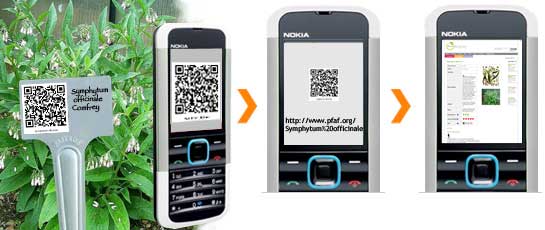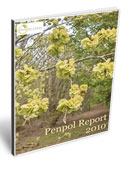|
Welcome to Plants For A Future’s Autumn Newsletter.
1. QR Codes and the Urban Physic Garden
2. Free Report on ‘The Field’
3. Image Update
4. Who Are You?
5. Website Tips
QR Codes and the Urban Physic Garden: What’s that all about?
Ever wandered around a garden and wanted more information on a particular plant? With these special barcodes you can quickly access more information using a smartphone. Each of our 7000+ plants in the database has its own unique barcode (QR Code). QR codes are a fast-track access to our website pages.
We have recently tested this new technology with the Urban Physic Garden in London for their summer festival of art, events and gardening. The festival’s garden aimed to temporarily transform an under utilised piece of urban ground, for 3-4 months from June to September 2011, for the benefit of local residents, workers and visitors.

So how does it work?
1. Copy and print a QR code to a plant label, poster, book, website, magazine, newspaper, etc., even t-shirts.
2. Smartphone users scan the QR Code which automatically takes them to the appropriate webpage on pfaf.org.
3. Smartphone users therefore quickly have the plants information on their phone.
 Free Report: Survey and Research Project on the 'The Field' Free Report: Survey and Research Project on the 'The Field'
A report is now available of the recently completed survey and research project on the 'The Field', the experimental site of Ken and Addy Fern ( Plants For A Future founders). They planted 1500 species of plants and carried out research on edible, medicinal and useful plants, suitable for growing outdoors in a temperate climate.
Download the it here [free, but we would appreciate a donation to help us maintain the website and database].
The Report was written by Dr Carol Wellwood, who also acted as Project Manager of the Survey and Research Project.

Image Update
One of our main goals for the year has been to complete sourcing and adding images to the plant database. With over 7500 plants it has been an onerous task that we are hoping to complete by December. We have added over 12000 images and now there are only 100 plants left to review. It has not been possible to source images for all plants but we will gradually add those missing as they become available. If you have plant images that are missing from the database please send them to [email protected].
We are also adding images to ‘Plant Uses’ pages to help identify plants. You can view an example click here.
There is now a quick reference list of our top rated plants with images. You can view edible plants click here and medicinal plants click here.
Who are you?
The PFAF website has over a million visits and 4 million page views per year. On average we have about 10 000 page views a day.
This year the PFAF database has been used by people in 219 countries/territories. The countries/territories are shown below (highest users first) United States, United Kingdom, Canada, India, Australia, France, Germany, Netherlands, Italy, Philippines, Spain, Portugal, New Zealand, Ireland, Romania, Greece, Sweden, Poland, Belgium, Czech Republic, South Africa, Turkey, Hungary, Malaysia, Norway, Mexico, Pakistan, Slovenia, Bulgaria, Denmark, Finland, Iran, Switzerland, Slovakia, Japan, Brazil...Get the full list click here .
Your Story
We would like you to send your stories about what they're doing and how PFAF has helped you - to be included in future newsletters and on the website. Stories can be as short or long as you please. Please email us at [email protected]
Website tips
The full bibliography used in the species database can be found and can be downloaded as a PDF file here.
 Tool tips. Hovering over the medicinal and edible uses descriptive term on the plant page will give you more information. For example, hovering over Vulnerary will show the information ‘Promotes the healing of wounds’. Tool tips. Hovering over the medicinal and edible uses descriptive term on the plant page will give you more information. For example, hovering over Vulnerary will show the information ‘Promotes the healing of wounds’.
For additional information on the edibility and medicinal rating, the hardiness scale, and the care icons on plant pages click on the blue information icon (i).


Plants For A Future
The main aims of the charity are researching and providing information on ecologically sustainable horticulture, promoting a high diversity, holistic and permacultural approach namely 'woodland gardening'. With the aim to use a minimal input of resources and energy, create a harmonious eco-system and cause the least possible damage to the environment whilst achieving high productivity.
The Plants for a Future Concept
It is our belief that plants can provide people with the majority of their needs, in a way that cares for the planet's health. A wide range of plants can be grown to produce all our food needs and many other commodities, whilst also providing a diversity of habitats for our native flora and fauna.
There are over 20,000 species of edible plants in the world yet fewer than 20 species now provide 90% of our food. Large areas of land devoted to single crops increase dependence upon intervention of chemicals and intensive control methods with the added threat of chemical resistant insects and new diseases. The changing world climate greatly affecting cultivation indicates a greater diversity is needed.
You're receiving this message because you are on this mailing list: PFAF Mailing list. If you would like to unsubscribe please send us a blank email by clicking here.
|